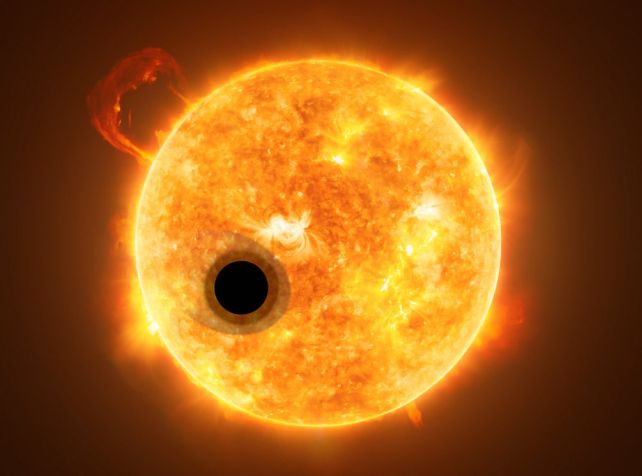For the first time, the JWST has given us a detailed breakdown of the interior of a world outside our Solar System.
The extremely strange exoplanet WASP-107b has an atmosphere surprisingly low in methane, which suggests that the interior of the exoplanet must be significantly hotter than we thought – and its core more massive too. This finally helps explain WASP-107b's cotton candy-like density.
Previously, WASP-107b had been thought to have quite a small core, surrounded by a huge puffy envelope of hydrogen and helium – which would have necessitated some changes to our understanding of how planets form and evolve. The new results mean that the exoplanet can be explained with existing models, without the need for radical revision.
"The Webb data tell us that planets like WASP-107 b didn't have to form in some odd way with a super-small core and a huge gassy envelope," says astronomer Mike Line from Arizona State University (ASU).
"Instead, we can take something more like Neptune, with a lot of rock and not as much gas, just dial up the temperature, and poof it up to look the way [WASP-107b] does."
Even when the discovery of WASP-107b was announced in 2017, we knew there was something strange about the exoplanet. By carefully studying how the exoplanet affected its host star, astronomers were able to derive its mass and radius, which revealed it had an incredibly low density.
Further analysis revealed that the density is so low that the world can be classified as a 'super-puff' – just 0.13 grams per cubic centimeter. Jupiter's average density, in comparison, is 1.33 grams per cubic centimeter, and Earth's is 5.51 grams.
We also know from those previous studies that the giant exoplanet orbits a star about 200 light-years away, with an orbital period of 5.7 days.
While that might seem short to us here in the Solar System, for puffy gas giants it's quite a loop that happens to make WASP-107b cooler than its peers – hot Jupiters with much smaller orbital periods whose expanded atmospheres can be explained by heat radiating from their star. WASP-107b's 'distant' orbit and relatively cool temperature made its puffiness challenging to explain.
So, two teams of astronomers, one led by Sing and the other led by ASU's Luis Welbanks, recruited JWST to take a look at the exoplanet's atmosphere.
As WASP-107b passes between us and its host star, some of the star's light is absorbed or amplified by molecules in the exoplanet's atmosphere. By studying the difference in the star's light with and without the exoplanet, and looking for brighter and dimmer wavelengths in the spectrum, astronomers can identify the fingerprints of specific molecules in an exoplanet's gas blanket.

While it's surprising that WASP-107b's atmosphere contains very little methane, this offers an explanation for how the exoplanet came to be the way it is.
"This is evidence that hot gas from deep in the planet must be mixing vigorously with the cooler layers higher up," Sing says.
"Methane is unstable at high temperatures. The fact that we detected so little, even though we did detect other carbon-bearing molecules, tells us that the interior of the planet must be significantly hotter than we thought."
This is one piece of the puzzle. Another piece involves the rest of what the researchers found in WASP-107b's atmosphere – including sulfur dioxide, water vapor, carbon dioxide, and carbon monoxide, with a higher content of heavy elements than either Neptune or Uranus.
By combining the ratios of the heavier elements to the lighter ones with how much energy is inside the exoplanet based on how much heat it generates, the researchers determined the size of WASP-107b's core. And they found that it was a lot bigger than we thought – 12 times the mass of Earth's core, and at least twice as massive as initially thought.
This means we don't need weird planetary formation models to explain its existence.
As for what is causing the core to be so hot, that's going to require further investigation. The exoplanet's orbit around its host star is slightly elliptical, which places changing gravitational stress on the planetary interior, heating it up from the inside. The researchers believe this is probably the source of the heat that makes WASP-107b so hot.
The two papers have been published in Nature. They can be found here and here.
